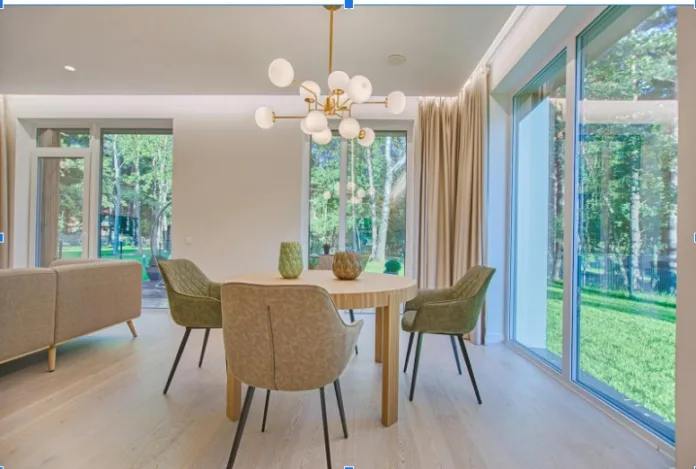Modern furniture does more than fill a space. In contemporary building designs, it serves as the silent ambassador of the aesthetic intent, bolstering architectural vision with each curve and line.
In this article, we will explore how the interaction between furnishings and architecture shapes experiences, marrying utility with undeniable allure to create something remarkable.
The Harmony of Minimalism
Modern furniture thrives on the principle of minimalism. It stands as both a contrast and a complement to the spaces created by contemporary architecture.
A sleek, minimalist coffee table, for instance, can anchor an open living area without overpowering it. This subtle equilibrium enhances the room’s airiness while providing functional value.
Selecting pieces with clean lines and understated elegance allows designers to amplify the building’s sense of space and light – essential components in modern design philosophies. Thus, less becomes more; every article of furniture is chosen not just to occupy but to perfect the balance within a room.
Function Meets Form
In the realm of modern building designs, furniture must do more than simply look the part—it must also solve problems.
Contemporary furnishings are designed with a dual purpose: to serve their primary function impeccably and to blend into the larger design narrative seamlessly. A modular sofa system, for instance, offers adaptability, enabling spaces to transform based on need without forfeiting style.
This synergy of practicality and aesthetics bolsters the functionality of each room while preserving the sleek sophistication that is central to contemporary architecture. The result is a living space where every piece fulfills its role with precision and poise, echoing the innovative spirit of modern design.
Elevating Through Color and Texture
In the symphony of contemporary architecture, modern furniture adds subtle yet impactful notes of color and texture.
Imagine the visual quietude of a monochromatic room being gently disrupted by a vibrant mid-century modern armchair or the tactile intrigue of a raw wood table amidst smooth concrete finishes. These are not just pieces; they are statements—intentional choices that elevate a building’s design narrative.
Such strategic use of color and texture enlivens spaces without detracting from their architectural gravitas. It creates focal points that draw the eye, inviting occupants to interact with space in a more personal, memorable way. This interplay allows modern furniture to elevate its environment, turning living areas into dynamic canvases of form and function.
Sustainability and Clean Living
Modern furniture is increasingly characterized by its eco-friendly materials and sustainable production methods. This harmony of ethics and aesthetics does not escape the discerning eye within contemporary architectural spaces.
The incorporation of furnishings crafted from recycled materials or renewable resources reflects a building’s commitment to environmental stewardship. A bamboo dining set or repurposed metal light fixtures speak volumes about the values held within the walls they adorn.
This alignment between modern furniture and eco-centric building practices underscores a holistic approach to design, where every choice has purpose and impact. It elevates contemporary buildings beyond their physical dimensions into testaments of responsible living and future-forward thinking.
The Tech-Infused Aesthetic
Modern furniture transcends traditional boundaries by embracing technology, offering a futuristic edge that complements contemporary building design. Furniture with built-in charging ports, seamless speaker integration, or responsive lighting elements are no longer novelties but expectations in modern interiors.
These tech-enhanced furnishings not only serve the digital demands of daily life but also echo the innovative architecture they inhabit.
The Interplay of Light and Shadow
Lastly, modern furniture plays a strategic role in shaping the interplay between light and shadow within contemporary spaces. The choice of furnishing can significantly influence how natural light filters and fills a room, creating dynamic patterns throughout the day.
A carefully positioned glass-top table can refract daylight, casting varied luminosity across minimalist interiors. Similarly, open-frame chairs and bookcases can invite light to pass through them, forming soft shadows that add depth and dimension to flat surfaces.
By tapping into the dance of light and shadow, modern furniture becomes an active participant in architectural expression. It’s a quiet yet powerful force, transforming static structures into living entities defined by time’s passage and the sun’s arc.
Image Source: Pexels

